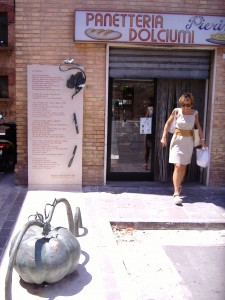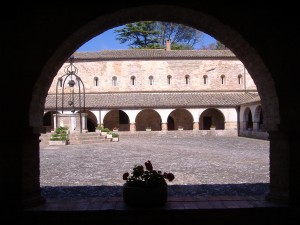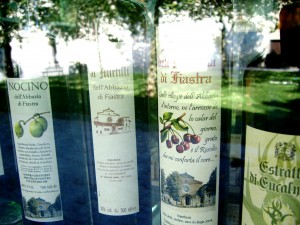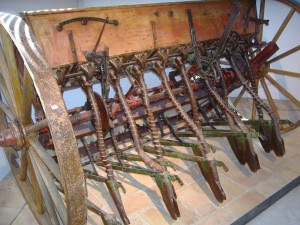Smaller American Lawns Today. Edible Estates. Freedom Lawns. Recent thinking about the American suburban lawn sounds like a microcosm of the debate about diversity and sustainability in agriculture in general. Read all about it in The New Yorker.
Nibbles: Desert garden, Funding, Vegetables, Communication, Ecosystem services, Bees, Native grasses, Soil, Raspberries, Ancient ag trade, Soybeans, Ag origins
- “See how beautiful you can make with small water!”
- IRRI redux.
- The problems of vegetable production in Africa, in microcosm.
- “This is a local production, storage and distribution system, a huge exhibit of biodiversity.’’
- PNAS special issue on ecosystem services.
- Bee books.
- Switch to switchgrass.
- More than you probably want to know about earthworms.
- Evil Fruit Lord questions Scotland-China raspberry deal.
- Ancient crop DNA recovered from underwater amphorae. Totally amazing.
- Nutritionist introduces soybeans to Afghanistan.
- Early PNG agricultural site added to UNESCO World Heritage list.
La Zucca
That early stirring of globalization that was the Columbian Exchange changed Italian food and cooking forever. That’s well known. What would pizza be like without pomodori and peperoncini, after all? There’s also polenta — and pasta e fagioli. And no doubt also traditional potato-based dishes, though I can’t think of one just now. But the third member of the Mesoamerican Trinity is often forgotten when the usual suspects of the exchange are trotted out, as I’ve just done.
Which is a pity, because the pumpkin features in some pretty nice dishes. 1 So it was nice to see it celebrated last week in Tolentino. We found this sculpture in the piazza which houses the regular fruit and veg market.
On the wall is the text of an ode to the vegetable (or fruit, but I’m not going there) by the local poet Giovanni Sebastiani (1874-1959). You can read “La Zucca” here. But don’t ask me to translate. The local Marche dialect is all but impenetrable to me.
Mash-up
 There’s an article in the latest Science entitled Celebrating Spuds. Unfortunately it is behind a paywall, so you may not be able to join in the celebrations. But even if you were, I’d suggest settling down with John Reader’s new book Propitious Esculent instead. I fancy myself moderately well informed about the potato but Reader served me with plenty of interesting new tidbits in addition to the usual fare. He has a terrific knack for putting things in context and for managing to take you off on detours so interesting that you hardly notice that you’ve deviated from the straightforward path. The silver mines of South America, for example, may well have been fuelled by potatoes, but the entire social set-up goes well beyond the potato as fuel and illuminates much of the Spanish conquest. Likewise, his very personal reminiscences of life in Ireland in the 1960s help to bring the great famine into perspective. His discussions of various food price crises in history is especially interesting today. When English farmers decided to abandon crops and instead grow sheep for wool, riding a boom in prices, there were riots in the streets over high prices for bread. Sound familiar?
There’s an article in the latest Science entitled Celebrating Spuds. Unfortunately it is behind a paywall, so you may not be able to join in the celebrations. But even if you were, I’d suggest settling down with John Reader’s new book Propitious Esculent instead. I fancy myself moderately well informed about the potato but Reader served me with plenty of interesting new tidbits in addition to the usual fare. He has a terrific knack for putting things in context and for managing to take you off on detours so interesting that you hardly notice that you’ve deviated from the straightforward path. The silver mines of South America, for example, may well have been fuelled by potatoes, but the entire social set-up goes well beyond the potato as fuel and illuminates much of the Spanish conquest. Likewise, his very personal reminiscences of life in Ireland in the 1960s help to bring the great famine into perspective. His discussions of various food price crises in history is especially interesting today. When English farmers decided to abandon crops and instead grow sheep for wool, riding a boom in prices, there were riots in the streets over high prices for bread. Sound familiar?
The one thing I didn’t find, and that may be because my memory is playing tricks on me, was a discussion of a mad scheme by a Geoffrey Pyke, a wonderful Englishman who is sadly all but forgotten. After World War II Pyke wrote a series of articles outlining the benefits of using teams of cyclists to haul railway wagons around Europe. He calculated that the energy in food, and the efficiency of human muscle, made this a far better bet than expensive fossil fuels. In my memory, the calculations were all based on feeding the teams of cyclists potatoes. But Wikipedia says it was sugar, and Wikipedia is never wrong. The articles were in the Manchester Guardian of 20, 21 and 24 August 1945. Alas, I can’t find those pages online, so I can’t check. But why would I have remembered potatoes if it really was sugar Pyke was talking about?
The Abbadia di Fiastra
So I guess you’ll have gathered the family and I were on holiday in the Marche region last week. One of the cooler places we visited was the Abbadia di Fiastra (that’s its cloister above). This is a romanesque abbey nestled in the middle of an ancient wood, which is now a protected area. Cistercian monks built the place in the 12th Century, reclaimed some of the land for agriculture by changing the course of the river Entogge, and also made use of the nearby forest, of course. You can still buy natural products made on the abbey’s land in the little shop in the visitors’ centre.
There’s an interesting Museum of Peasant Culture at the abbey. Actually it mainly consists of old farm machinery and utensils. This was one of the more interesting exhibit, a seminatrice, or seed sower.
I talked to my friend the farmer about it. He remembers when tractors first came into the region, in the sixties. He remembers sowing and harvesting using machines such as this, pulled by horses or cows. He had heard of the museum, but didn’t think much of the idea.



